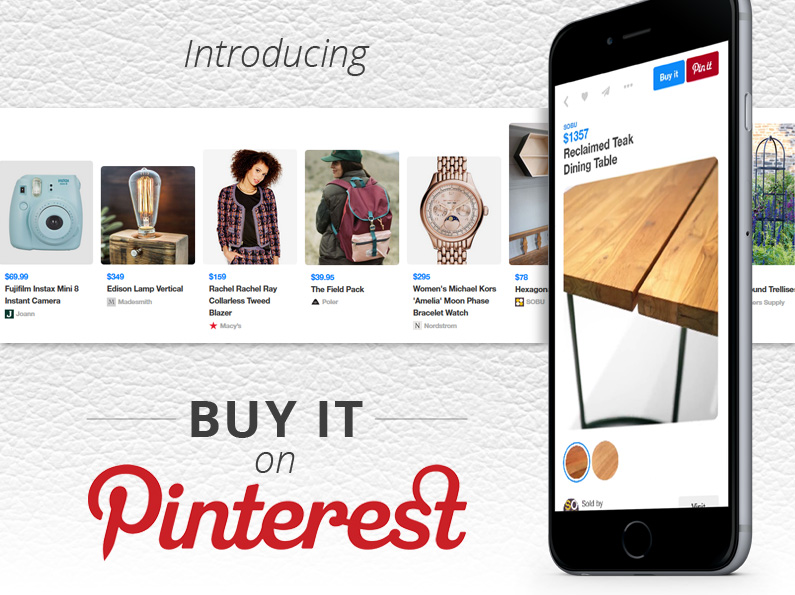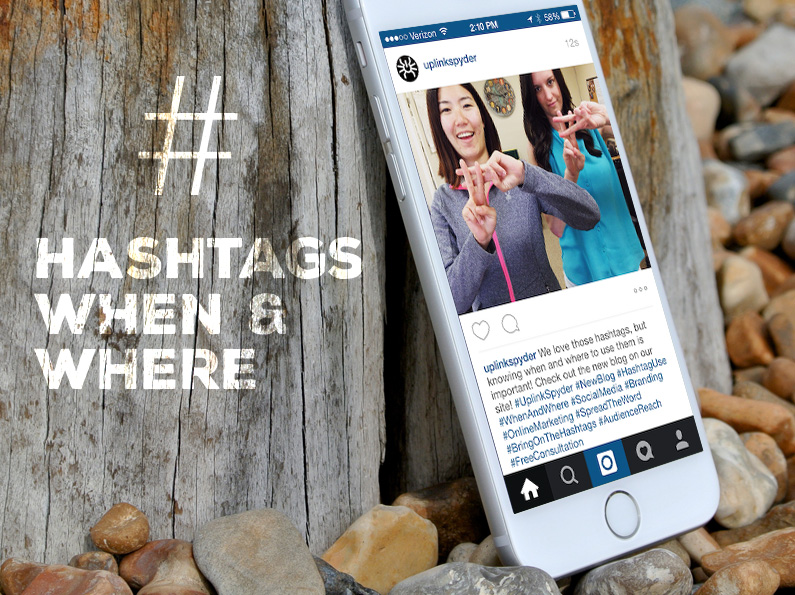
by Administrator | Jul 2, 2015 | Social Media
Pinterest recently announced that it would be incorporating a new Buyable pin feature. Brands and products supported by the feature will have a “Buy It” button, allowing customers to purchase the item directly through the Pinterest app. Already a successful social media platform, Pinterest may gain even more of a following in these coming weeks, thanks to this new feature.
For those not already familiar with Pinterest, it is a digital pin-board that allows you to post, re-pin, and categorize items, trends, and information. It’s particularly beneficial when trying to establish a brand, and the people and inspiration behind it, in various fields and passions.
Why should businesses care about Pinterest?
- It’s currently one of the top 3 social networks, with the fastest growing rate.
- It includes back links to business websites, a SEO ranking signal, and increases visibility to potential clients and customers.
- It’s not just for images and products. Text-based content, such as “How-To” articles, are highly welcomed and show 30% more engagement.
- Similar to Twitter’s “retweet” feature, Pinterest allows followers to “repin”, improving audience engagement and gaining exposure for your pins and your business.
Tips for Using Pinterest for Your Business
Connect your website to your Pinterest account. Make sure your website address is in your profile bio section, all pins link back to your business, and your website has a Pinterest link so customers can find your account quickly.
Follow the Pinterest Verification Process. This will not only help your business gain a trusting following, but will also allow you to see website traffic and analytics with a Business account.
Utilize keyword placement. Optimize all images with descriptive keywords to link to related content on your website. Place keywords towards the front of board names and pin descriptions.
Descriptions should be 200-310 characters long. Be clear and informative. Shoot for clarity rather than wit.
Include Calls to Action. Potential customers should have a clear path from your pin to your content and/or product.
Be consistent with your sharing strategy. 70% of pin clicks occur within the first 2 days. At least 5 pins per day is a good starting point.
Pin on Saturdays, afternoons, and evenings. Pin when your audience has a chance to sit down and browse.
Vary types of pins and board categories. Providing a range of material shows expertise and knowledge in your area. Include a board to showcase your newest or most popular products, services, and promos.
Visit UplinkSpyder’s profile on Pinterest.

by Administrator | May 22, 2015 | Review Management
What are your customers saying about you? Every business has an online reputation or the potential for one. An online rep is based on many factors including physical and online appearances, efficiencies, and most importantly, the interactions between the business and its customers.
Online reviews can affect your visibility in search engines and directories. They increase your credibility, which creates an edge over your competitors leading to increased ROI and more success in your business.
Having a reputation is inevitable, but having a good one can and should be cultivated. One of the best ways to create a positive online reputation is by emphasizing the importance of reviews within the culture of your business. 88% of customers say they trust online reviews as much as personal recommendations; therefore, it’s an important aspect to any online marketing strategy.
Some Things to Know About Review Strategies
No reviews = bad reviews. Having no reviews leaves your reputation in a vulnerable state. One bad review will automatically set the tone for every other potential customer that visits your site. Without reviews, you do not have an established reputation, which may seem like a warning to visitors. A wide array of reviews is far better than no customer presence at all.
Positive reviews increase traffic online and on location. Positive reviews generate higher rankings in many online directories, which leads to higher traffic on your website and at your location.
Niche review sites are important. Sites like Google+, Yelp, Facebook, etc., are crucial for your online reputation, but you shouldn’t ignore the smaller niche sites. Finding a great niche site for your industry will improve your online presence.
Get the Most Out of Your Customer Reviews
Do not provide incentives for reviews. Providing an incentive to your customer in order for them to submit a review is generally not a good idea. Sites like Yelp and Google+ penalize businesses that do this, which is detrimental to your online reputation. It also cheapens the relationship between you and your customer. Encourage genuine reviews by providing great service.
Have a proactive response to bad reviews. Bad reviews should not be ignored. Follow up with the customer to resolve issues that arise. Contact them and inquire about more feedback to improve what they did not like about their experience with your business. After showing your concern, ask them if they would consider trying your business again and possibly revising the review. Even a small change could impact your online reputation in a positive way.
Use reviews to improve your business. Rather than just trying to get a good review, utilize all reviews, especially negative, to improve the experience or product for your customer. There is always room to improve.
Be persistent when asking for reviews, and make it known to your staff. Constantly asking for reviews improves the likelihood that your customers will take the time to give you feedback. Everyone involved with your business should be active in this area in order to optimize your chances of bringing in the most responses.
Reviews should not be a one-time pursuit. Your review strategy should be an ongoing process. An abundance of old reviews does nothing for your reputation if they are outdated. Maintain your review strategy in order to keep your business relevant.
UplinkSpyder can help you plan for, implement and manage, a high-quality review system. Let us help you; Contact Us today for a free consultation.

by Administrator | May 8, 2015 | Social Media
Since their origin on Twitter, hashtags have become popular on almost every social media platform including Facebook and Instagram. As a business owner, hashtag use can be a great marketing tool that can enhance your marketing campaigns when used correctly. Through hashtag association, your post and company can achieve far more reach and exposure. However, to be successful with hashtag use, you should know when to use them, when to avoid them, and when to use them in moderation.
Instagram
Instagram is all about the hashtags. Posts with 11 or more have shown the highest interaction with users. With Instagram, the more hashtags you use, the better. Here’s an example:
Twitter
1 or 2 hashtags per tweet is key. Tweets with hashtags get twice as much engagement than tweets without; however, when you have more than two, engagement drops 17%. Use hashtags on Twitter, but don’t go overboard.
A great way to incorporate hashtags on Twitter is posting during the days leading up to an event or live-tweeting the event itself. It gives your tweet relevancy and a great chance to reach a new audience.
Facebook
Facebook posts without hashtags seem to perform better than posts with them. Occasionally, hashtags help your posts build a community, but it’s rare and it’s usually better to leave your posts hashtag-free. Tags and mentions are far more successful.
Overall, your hashtags should be unique and/or relevant. You should try to make your hashtag memorable and specific to your brand, but also simple. Research it before publishing a post to make sure it won’t be misinterpreted as something else. Most importantly, your message should be easy to understand and provide a clear call-to-action for your viewers.
If you need help with hashtag use or social media in general, UplinkSpyder has you covered. Our team of social media experts understand the importance of online marketing and can increase the success of your business using educated strategies. Contact us today to start improving your brand.
by Administrator | Dec 19, 2014 | Marketing, Strategy
The Christmas shopping season is one of the busiest and most important times of the year both for our clients and our company. In order to get the most out of consumers’ expanded need to make purchases this time of the year, retailers and marketers need compelling holiday campaigns across multiple channels. The same strategies apply throughout the year as other holidays and opportunities arrive. Other seasons and celebrations can be equally if not more important to you and your business and unlike Christmas, may not have as much competition for your consumer’s attention. The following helpful tips and strategies should be considered when creating any marketing campaign around a specific season or celebration.
Plan Ahead: Don’t start planning your marketing strategies days or even a few weeks before certain holidays. Planning your holiday campaigns a few months in advance will give you time to adjust to any changes and won’t have you throwing rushed, low-quality campaigns together at the last minute. Create a schedule and include specific weekly and daily tasks for each channel. Create assignments for people in your organization.
Be Creative and Generous: Use your creativity and the various channels at your disposal. A few ideas we’ve had success with include:
- Run a Facebook exclusive promotion that you only post and promote on your Facebook page for your fans.
- Use Pinterest or Twitter to run a re-pinning or re-tweeting contest for your followers.
- Send out weekly or daily newsletters counting down to the big day that include a deal in each.
- Offer larger promotions specific to well-known shopping days like Black Friday, Small Business Saturday and Cyber Monday.
- Create a “Last Minute Gift” promotion closer to Christmas. Most people shop online now, so offer promotional codes and make sure these codes are working before sending them out to your audience.
Engage Your Audience: Make your customers and fans feel special. Ask them via Facebook or Twitter what products they want or would like to see more of for the holidays. Use unique hashtags for them to use to interact with you. Consider running a photo contest or a “Caption This Photo” contest and have them submit their own photos or sayings. This makes them feel special, but more importantly it keeps them coming back to your page.
Show You Care: Show your customers and fans that you are a considerate and philanthropic company. You can start by partnering with a local charity or non-profit organization. Host a donation drive or volunteer at a charity event that benefits this organization. Helping those in need shows your audience you care about more than just sales.
Be Festive! Your clients are showing their spirit, so why shouldn’t you? Create festive graphics to utilize across all channels, including your website. Decorate your place of business and post photos of the décor and your happy helpers (employees). In the midst of all the promotions you are running, your audience will appreciate the occasional “fun” post or photo. It is also smart to create a special newsletter to send out. Something as simple as “Happy Holidays from All of Us” or “We are Thankful for You” shows that you appreciate their patronage.
Hopefully these tips will help you get an idea for a successful holiday campaign. Start planning your marketing strategy for the next holiday, celebration, or season using engaging and creative campaigns that will excite your audience and give you more brand awareness and sales.


